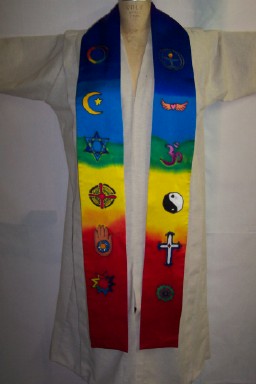 I was flipping through my copy of Newsweek the other day and came across a headline that almost made me swoon. To make matters more interesting for people who care about religion news, this little article was part of the magazine's giant "What You Need To Know Now" spread.
The headline said: "True or False: The Major Religions Are Essentially Alike."
I was flipping through my copy of Newsweek the other day and came across a headline that almost made me swoon. To make matters more interesting for people who care about religion news, this little article was part of the magazine's giant "What You Need To Know Now" spread.
The headline said: "True or False: The Major Religions Are Essentially Alike."
According to author Stephen Prothero of Boston University, the correct answer is "false." Prothero is, of course, the author of the new book Religious Literacy: What Every American Needs to Know -- And Doesn't.
Here is now the Newsweek article opens:
At least since the first petals of the counterculture bloomed across the United States in the 1960s, it has been fashionable to affirm that all religions are beautiful – and all are true. The proof text for this happy affirmation comes, appropriately enough, from the Hindu Vedas rather than the Christian Bible: "Truth is one, the sages call it by many names."
According to this multicultural form of wisdom, the world's religions are merely different paths up the same mountain. But are they?
Anyone willing to deal with facts and doctrines, rather than emotions and fog, has to come to the conclusion that the various world religions clash over and over again, creating eternal divides that are real and can only be covered up by living in a state of denial, according to Prothero.
Yet that is precisely where many people – including scores of journalists – like to live. Here is the heart of the Newsweek article:
You would think that multiculturalists would warm to this fact. But instead they try to flatten out diversity by pretending that the differences between, say, Judaism and Taoism are more apparent than real. ...
But understanding real religious diversity – the undeniable differences demarcated by religious boundaries – is essential to understanding the powerful role that religious beliefs, practices and institutions play in the world today.
I do not believe that we are witnessing a "clash of civilizations" between Christianity and Islam. But it is a fantasy to imagine that the world's two largest faiths are in any meaningful sense the same, or that interfaith dialogue between Christians and Muslims will magically close the divide between them. Even Shia and Sunni Islam are in many respects quite distinct – a fact American officials might have learned before things in Iraq went awry if our public schools had not been treating this subject as taboo for generations.
Faith may or may not move mountains, but it is doubtless one of the prime movers in politics, both in the United States and (with the notable exception of Europe) abroad.
It may be scary to accept reality, he concludes, but the "world is what it is." It is hard to build true tolerance and respect (and accurate news coverage) on lies.
This Newsweek mini-essay really stuck in my mind because of something I heard several years ago, when I had a chance to take part in a conference on religion and the news held at the University of Nebraska's School of Journalism. The keynote speaker was Dr. Martin Marty of the University of Chicago, who has, over the past few decades, been one of the most important voices pleading with the mainstream media to do a better job of covering religion news.
During his lecture – which focused on the impact of Sept. 11, 2001, on mainstream news – Marty noted that one of the most powerful beliefs among journalists is that the number of people who cling to traditional forms of religion will decrease in the years ahead and that the number of people who embrace more liberal forms will increase. This belief does much to shape their coverage of the news.
Meanwhile, one of the core convictions of the leaders of the religious left is their conviction that the various world religions are, in the end, the same and, thus, all equally true. Many elites in our culture go even further and assume that the religion will fade – period.
Here is the key quote from a column I wrote about that Marty speech:
Thus, the West has been dominated by two big ideas.
"One idea was that every time you looked out your window, there was going to be less religion around than there was before," said Marty. ...
"The other idea was that whatever leftover religion you find, it was going to be tolerant, concessive, mushy and so on. Instead, there has been an increase in religion and the prospering religions are all extremely intense. The versions of Catholicism, Protestantism, Judaism, Islam, Hinduism and Buddhism that are prospering tend to be among people who care very much about what their faith is about."
So, combine the insights of Marty with the hard, cold fact stated by Prothero. The result will be sobering news for many mainstream journalists.
However, the world is what it is.
